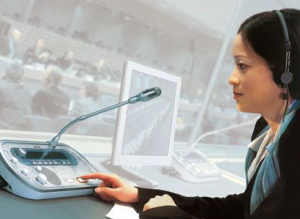Simultaneous interpreters: a profession with standards
by
Whether they be doctors, engineers, lawyers, dentists, architects, mechanics, translators or simultaneous interpreters, all professions need to have standards. What are they?
Standards are rules on how a profession behaves, how it acts, to provide the services it renders to society in a manner that satisfies the needs and expectations of consumers. For instance, if you ask an architect to design your house, you expect the roof to be supported by beams strong enough to carry its weight and resist storms. Architectural standards prescribe the dimensions of beams, according to their material, so that they can do this.
Standards are set by the respective professions or by international bodies, such as the International Standards Organisation (ISO) or, in the case of foods, by the Codex Alimentarius (FAO/WHO). Other bodies also set standards. Our interest here is in standards set by a profession.
The standards for conference and simultaneous interpretation are set by the International Association of Conference Interpreters (AIIC). At its 36th Assembly in Addis Ababa, in January 2015, AIIC members discussed, among other things, the importance of adhering to our professional standards, in the face of an increasing number of cases of sub-standard simultaneous interpretation at international conferences. Read more
What are AIIC’s professional standards for simultaneous interpreters?
Their main elements are:
- Simultaneous interpreters must be qualified and certified
- Simultaneous interpreters work in teams
- Number of simultaneous interpreters per language, according to the number of languages used at a conference
- Working hours and rest periods
- Language combinations
- Same remuneration for all interpreters on a team
- Travel conditions and rest before an assignment
- Professional domicile (place from which interpreters are hired)
- Interpretation booths and equipment.
Why are standards in our profession and in others important?
Conference interpretation, whether simultaneous or consecutive, is an extremely difficult and tiring activity, which taxes interpreters’ brains and energy severely. That is why our standards require that we work in teams of two or more simultaneous interpreters per language, so that we can alternate every 30 minutes. And that we work no more than two sessions of approximately 3 hours per day. Otherwise we would not be able to perform our duties for long. We would be mentally and physically exhausted. The quality of our interpretation would drop dramatically. That means delegates would no longer understand what is said and the purpose of interpretation – namely communication – would not be achieved.
Simultaneous interpretation is the most common form of interpretation used at conferences. It happens in interpretation booths (link to ISO standards). These sound-proof boxes with windows allow simultaneous interpreters to listen to speakers and interpret what they say into a different language at the same time. These booths must conform to the ISO standards so that interpreters can hear, see, breath and speak in comfort. The physical conditions must not detract from our ability to concentrate on the speaker’s message and convey it correctly in another language.
Without standards, interpreters cannot do their job properly and ensure crystal clear communication, which is what they are hired for.
Language combinations for simultaneous interpreters
Professional simultaneous interpreters know and work in two or more languages. They always work into their mother tongue or main language. This is what AIIC standards call “A” language. Many also work into their second main language, their “B” language. And some know 2 or more other languages (“C” languages) from which they work into their “A” language. The “A”, “B” and “C” languages for one interpreter are called her or his language combination.
Take the case of a conference in French, English and Spanish. A delegate speaks in English. The simultaneous interpreters working into French will listen to English and interpret into their “A” language – French. Those working into Spanish (their “A” language) will work from English into Spanish. If a delegate speaks Spanish, the English “A” interpreters will work into English.
That means the French interpreters must know English and Spanish; the Spanish interpreters must know English and French. And the English interpreters must know French and Spanish. In this way, relay interpretation is avoided.
Take the case of a conference in French, English and Spanish. A delegate speaks in English. The simultaneous interpreters working into French will listen to English and interpret into their “A” language – French. Those working into Spanish (their “A” language) will work from English into Spanish. If a delegate speaks Spanish, the English “A” interpreters will work into English.
That means the French interpreters must know English and Spanish; the Spanish interpreters must know English and French. And the English interpreters must know French and Spanish. In this way, relay interpretation is avoided.
Relay interpretation occurs when an interpreter does not know the speaker’s language and listens to another simultaneous interpreter (a different language booth) who is translating that speaker into a language the interpreter does know, in order to interpret into her/his language. This happens a lot for Asian languages, such as Chinese, Korean, Japanese, Thai, because Asian simultaneous interpreters usually know their own mother tongue and English only. Rarely do they master a third language, such as Spanish or French. So they are obliged to listen to the English interpretation when a French or Spanish delegate speak.
Similarly, European-language interpreters rarely speak Chinese, Korean, Japanese or other Asian languages. When one of those is spoken by a delegate, they have to listen to the English provided by the Asian language booth, so as to interpret into their European language.
European traditions and Asian traditions
In Asia, most conferences need interpretation from and into English, from one or more Asian languages. This entails that interpreters work in bi-lingual booths, meaning they interpret from English into say Korean or Chinese, and back from those languages into English. Therefore, most simultaneous interpreters are bi-lingual. One may say that the Asian language combination standard is bi-lingual: English + Asian language.
People sometimes forget that a simultaneous interpreter can also work from other languages, that is can have more than two languages. Users of interpretation often ask for Chinese<>English interpreters, or French<>English interpreters, without mentioning that the conference will use say English, Chinese, French and Spanish.
In Europe, most conferences use four, five or more languages. They therefore look for simultaneous interpreters who cover most of those languages. They prefer not to use bi-lingual interpreters, as these will not know enough languages. Most organizers will try to avoid relay interpretation, as it increases the risk of errors and slows down communication. So you can say the European language combination standard is multi-lingual.
That is also the standard used by AIIC (which originated in Europe) and explains the classification of interpreters’ languages into “A”, “B” and “C”.
Being perfectly fluent in more than one language, and applying professional standards for interpretation, leads to the result observed by this reporter:
What is simultaneous interpretation?
From an article by Geoff Watts in Mosaic – 18 November 2014
Let’s unpick what she did that morning and itemise its components.
As the delegate spoke, the interpreter had to make sense of a message composed in one language while simultaneously constructing and articulating the same message in another tongue. The process required an extraordinary blend of sensory, motor and cognitive skills, all of which had to operate in unison. She did so continuously and in real time, without asking the speaker to slow down or clarify anything. She didn’t stammer or pause. Executing it required versatility and nuance beyond the reach of the most powerful computers. It is a wonder that her brain, indeed any human brain, can do it at all.














